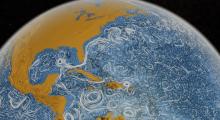Much like the ocean currents he studies, MIT Oceanographer Glenn Flierl is a quiet force. He has been a fixture in the Department of Earth, Atmospheric, and Planetary Sciences (EAPS) for nearly 40 years and continues to generate a substantial body of groundbreaking work. But he eschews the spotlight that accompanies such success, instead preferring to focus on the science. Described by colleagues as a big thinker, Flierl is no doubt an integral part of MIT’s ocean community.
Flierl’s interest in the ocean stemmed from an unlikely place—youthful summers spent in Falmouth, Massachusetts, working for the Light Opera Theater Company. When he wasn’t building sets, Flierl and his theater friends would go to the beach. It was during one of these trips that he met a mutual friend who worked at Woods Hole Oceanographic Institution. “I realized you could do physics about the ocean!” Flierl said.
He kept that notion in mind when applying to graduate school. Flierl earned a bachelor’s degree in physics from Oberlin College, but “knew nothing of oceanography at that point,” he said. “I picked a school where I had the option [to explore the field].” Flierl enrolled in Harvard University where he worked closely with the late Allan Robinson, a professor of geophysical fluid dynamics, studying ring formations in the Gulf Stream—an intense, warm current in the western North Atlantic Ocean. They were interested in using the rings as a sort of contained ocean laboratory to observe how biological, chemical, and physical properties changed over time. After earning a doctorate in 1975, he joined MIT’s Department of Meteorology and Physical Oceanography (which soon merged with the Department of Earth and Planetary Sciences to become EAPS), and has remained there ever since.
Soft spoken with a voice some say is reminiscent of Clint Eastwood, Flierl embodies a typical college professor more than Dirty Harry. Stacks of books and papers clutter his office overlooking the Charles River, and equations and diagrams populate the chalkboard—hallmarks of a dedicated scientist. “Glenn is always interesting, he’s probably the smartest person around,” said Raffaele Ferrari, an MIT oceanographer and Flierl’s frequent collaborator. “If you want someone to give you perspective, a good theoretical underpinning of anything you’re trying to work on, he’s great.”
Evolving Turbulence
Over the years, Flierl has mainly focused on the physics of ocean turbulence—how properties like eddies, jets, and nonlinear flows form—and its implications for biological life. The distribution of ocean ecosystems is strongly determined by turbulence, the transport of materials such as nutrients and heat, and biological interactions. “In some ways there’s been a lot of work on the biology without the physics,” said Flierl. “A lot of work now is trying to build biological models into the physics, but the models are often too simple or too intricate. We have a long way to go to understand how transport by the flows are reacting with biological processes.”
Recently, his interest in this area has drifted toward evolution. Flierl is modeling the coevolution of predators and prey, such as zooplankton and phytoplankton, in context of ocean mixing and transport. Earth’s upper ocean is home to a variety of diverse ecosystems as well as intense turbulence. As predators and prey compete in an evolutionary arms race, continuously outmaneuvering each other in the fight for survival, they also face a changing environment. In addition to natural speciation, Flierl’s initial findings suggest that ocean turbulence also contributes to the evolution of new species by changing the playing field. “As soon as you start to slightly mix up the environmental gradient, things like temperature or salinity, the competition actually causes [predators and prey] to appear in discreet groups,” he said. The next step is to examine this dynamic in areas of the ocean where mixing is more complex.
[...]
Read the full article at the link below.
Link to article:




